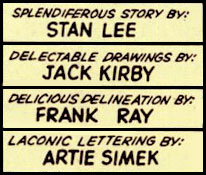![]()

Why did some artists working for Marvel in the sixties use phony names?
Because DC editors sometimes frowned on "their" people working for the competition. There was a certain arrogance behind it, along with the fear that if you were working for someone else, you might not be spending every waking minute on your DC assignments. You'd lose stature around DC (where some liked to believe their standards were so much higher than any other company's) and the fact that you were willing to work for Marvel's lower rates wouldn't help you to get a raise if you continued working for DC. Ergo, until such time as you felt the Marvel work was steady, you might elect to hide behind a pen name.

This was sometimes a sudden decision, as you can see from the credit box above, which is from Fantastic Four #39. Frank Giacoia was scheduled to ink the issue and from the spacing, it's obvious that when Artie Simek did the lettering, he inscribed Giacoia's whole name. Then Giacoia inked the issue and apparently chickened-out and asked to have his pseudonym — which he'd been using on all his previous Marvel work — substituted. Someone whited-out his last name and lettered in "Ray." A lot of the bogus credits are like this…last-minute substitutions of the fake name for the real.
This whole topic, by the way, usually prompts the question, "Couldn't the DC editors recognize the artists' work?" And the answer to that one is that…
1. Some could not. You'd be amazed how many people who've worked in comics — often in high-ranked positions — couldn't and still can't tell Kane from Kirby.
2. Most DC editors didn't look too carefully at the Marvel books. (Some didn't even look at the DC books from other editors) and…
3. The bogus names provided a certain level of deniability. If caught, an artist could say, "Oh, I was just doing some ghost work to help out a friend. I wouldn't work for Marvel."
Here's a guide to some of the folks who elected to hide, at least at first, the fact that they were working there…
- Gene Colan worked under the name "Adam Austin"
- Jack Abel inked some of Adam Austin's work under the name "Gary Michaels"
- Werner Roth passed himself off for a time as "Jay Gavin"
- Gil Kane drew one Hulk story as "Scott Edward"
- Jerry Siegel wrote The Human Torch as "Joe Carter"
- Frank Giacoia was actually doing the work credited to "Frank Ray" (Once Giacoia was working primarily and openly for Marvel, he did some inking jobs for DC that were credited to "Phil Zupa.")
- Robert Bernstein wrote scripts as "R. Berns"
- George Roussos inked under the name "George Bell"
- Jim Mooney inked as "Jay Noel"
- Bill Everett was occasionally credited as "Willie Bee" or "Bill Roman." (Roman, of course, is "Namor" spelled backwards.)
- Jack Katz drew some stories under the name "Jay Hawk"
- Sam Kweskin worked briefly under the name "Irv Wesley"
- And Mike Esposito set the house record for pen names, working as "Mickey Demeo," "Mickey Dee" and "Joe Gaudioso"
Also, Don Rico did a few pseudonymous scripts for Marvel under the name of "N. Korok" and Ernie Hart did a few as "H.E. Huntley." Rico told me he used the pen name because he was writing novels at the time and didn't want his publisher to know that he was taking on other work, and for low money. I have no idea why Hart so elected but it was probably something similar.
Lastly, there were quite a few issues of Millie the Model and other teen comics signed by Sol Brodsky or "Solly B." Brodsky was the firm's Production Manager and an occasional inker, and he did ink a few of the Millie stories that bear his credit. But they were all at least pencilled by Stan Goldberg. At the time, Stan was doing occasional work for the Archie Comics people, and they didn't like to see their artists drawing in that style for other publishers. So when Stan drew teen comics for Marvel, they put Brodsky's name on them in the hope that the Archie editors wouldn't know it was him.